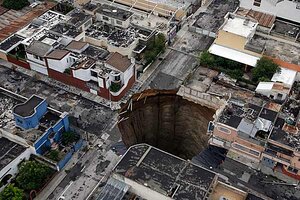Geologists baffled by what to do with giant Guatemala sinkhole
Scientists say filling the giant Guatemala sinkhole isn't as simple as just dumping in gravel and dirt. First, geologists have to understand the conditions that caused it.

A sinkhole covers a street intersection in downtown Guatemala City on Wednesday.
Moises Castillo/AP
The giant sinkhole that opened up in Guatemala City Sunday has geologists scratching their heads and observers calling for better safety controls, but the more pressing issue: What do you do with a sinkhole?
Do you fill it? Will it get bigger? What caused it?
With smaller sinkholes often found in yards after rains, or as the result of digging, experts recommend dropping a concrete slab, gravel, or other solid material to the bottom of the hole, filling with clay-like soil, and finishing with topsoil. The material will usually settle, and it may be necessary to add more soil over time.
IN PICTURES: Guatemalan sinkhole
"You need to have some sort of mechanical structural support at the base of your fill material," says Jim Currens, an expert on sinkholes, caves, and springs with the Kentucky Geological Survey.
But Guatemala's sinkhole is on an exploded scale, and the geological makeup of the region makes predicting the cause and any effective remedies difficult.
The country has some experience with large sinkholes, as it turns out. In 2007, a 330-foot-deep sinkhole opened up in Barrio San Antonio, just 15 blocks away from the current one in Ciudad Nueva. That sinkhole is thought to have been caused by a broken storm drain pipe that over time weakened and washed away the ground above it.
The burst water pipe theory makes sense to Mr. Currens. "Any conduit carrying water is always an exacerbative or causative factor," he says.
Some believe the two Guatemala City sinkholes are linked to government neglect of the area, and are calling for better accountability so that something like this doesn't happen again with worse results. “If there have now been two holes that have appeared along the same line, chances are there could be a third one developing elsewhere,” Luis Figueroa, a journalist living in Guatemala told the Daily Beast. [Editor's note: The original version has been adjusted to include attribution.]
But geological experts are cautious about assigning blame. Looking at photos of the most recent Guatemala sinkhole, it's clear that there were preexisting conditions – an underground cavity that may have been present for generations, says Mark Kasmarek, a groundwater hydrologist with the United States Geological Survey (USGS). "Once the roof of that cave becomes compromised through time, it can no longer support what's on top of it," he says.
Simply filling the hole won't help, says Mr. Kasmarek, without first studying the geological makeup of the surrounding area to determine the underlying factors that caused the collapse.
IN PICTURES: Guatemalan sinkhole
Related:
